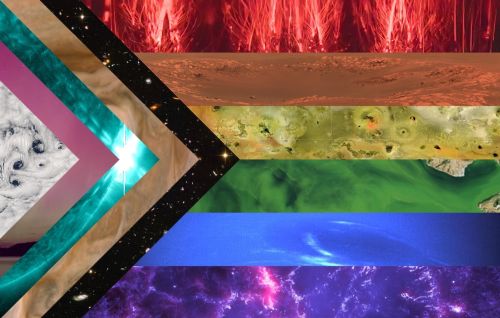Your personal Tumblr journey starts here
Nasa - Blog Posts

I'm not the first or last to see this and post it but this is my serotonin for today.


Above image is a pride flag with every color band represented by a NASA image. White is Earth clouds, pink is aurora, blue is the Sun in a specific wavelength, brown is Jupiter clouds, black is the Hubble deep field, red is the top of sprites, orange is a Mars crater, yellow is the surface of Io, green is a lake with algae, blue is Neptune, and purple is the Crab Nebula in a specific wavelength.


Above image is a pride flag with every color band represented by a NASA image. White is Earth clouds, pink is aurora, blue is the Sun in a specific wavelength, brown is Jupiter clouds, black is the Hubble deep field, red is the top of sprites, orange is a Mars crater, yellow is the surface of Io, green is a lake with algae, blue is Neptune, and purple is the Crab Nebula in a specific wavelength.
What do you do when you almost die in space? Leonov drew the orbital sunrise.

Alexei Leonov was the first person to walk in space. When he couldn’t sleep after pressurisation in his suit meant he almost couldn’t get back into the capsule, Leonov picked up his sketchpad and pencils to create the first art in space.
Green (2021):
‘A curved band mixing black and blue represents the portion of Earth visible due to the rising sun. Above the planet, a narrow curvature of red, then yellow, and then the black of space. And in the center of the drawing, we see the red sphere of the sun, almost risen behind the curvature of the Earth. It says something to me that the first art made by humans from outside of Earth's atmosphere depicts Earth's atmosphere.
Leonov was astonished by the brightness of the stars from space, but he did not draw that, nor did he draw himself floating, looking up at the spaceship. He drew home. He drew what Mary Oliver memorably called "this, the one world we all belong to."’


Though we see the orbital sunrise in a more photorealistic way now (NASA, 2021), Leonov’s shows what it might feel like. The awe to see all of humanity’s history in one place, all humans who had ever existed except himself and his team.
‘I like to look at Leonov's drawing when I am exhausted by despair and drudgery, or when I feel the weight of longing and fear pressing in on my chest. I look at the picture and think of all that had to happen for the drawing to exist, for Leonov to exist, for anything to exist. I look at the drawing and take a long, slow breath, and think of how my lungs were made for this air.’
Quotations from John Green’s The Anthropocene Reviewed (2021), images from Brown (2015) and NASA (2022)
September 15
This one is technically not yet history, because at the time of posting, the little craft has about half an hour left to go. That said, let’s proceed.
In 2017, NASA’s Cassini space probe ended its twenty-year mission at Saturn. After a nearly-seven-year-long journey there, it orbited the ringed planet for 13 years and just over two months, gathering copious amounts of information about the planet, said rings, and many of its moons. It landed an ESA probe called Huygens on Titan, the first-ever soft landing in the outer Solar System. It discovered lakes, seas, and rivers of methane on Titan, geysers of water erupting from Enceladus (and passed within 50 miles of that moon’s surface), and found gigantic, raging hurricanes at both of Saturn’s poles.
And the images it returned are beautiful enough to make you weep.
On this day in 2017, with the fuel for Cassini’s directional thrusters running low, the probe was de-orbited into the Saturnian atmosphere to prevent any possibility of any contamination of possible biotic environments on Titan or Enceladus. The remaining thruster fuel was used to keep the radio dish pointed towards Earth so the probe could transmit information about the upper atmosphere of Saturn while it was burning up due to atmospheric friction.
This is us at our best. We spent no small amount of money on a nuclear-powered robot, launched into space, sent it a billion miles away, and worked with it for two decades just to learn about another planet. And when the repeatedly-extended missions were through, we made the little craft sacrifice itself like a samurai, performing its duty as long as it could while it became a shooting star in the Saturnian sky.

Rhea occulting Saturn

Water geysers on Enceladus

Strange Iapetus

Look at this gorgeousness

A gigantic motherfucking storm in Saturn’s northern hemisphere

Tethys

This image is from the surface of a moon of a planet at least 746 million miles away. Sweet lord

Mimas

Vertical structures in the rings. Holy shit

Titan and Dione occulting Saturn, rings visible

Little Daphnis making gravitational ripples in the rings

That’s here. That’s home. That’s all of us that ever lived.

Saturn, backlit

A polar vortex on the gas giant

Icy Enceladus
(All images from NASA/JPL)